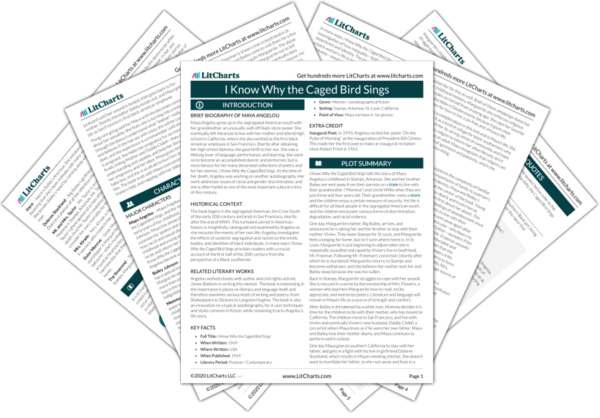Summary
Analysis
Marguerite is graduating from the eighth grade. It is a very special occasion, and she enjoys that she is able to have her moment. She wears a gorgeous yellow dress handmade by Momma and feels pretty and important. She is deeply excited for the ceremony—on the morning of her graduation she is overcome with gratitude to God for allowing her to live to see this day.
Marguerite’s graduation presents her with a much-needed opportunity for affirmation and congratulations. Her thanking God shows her spirituality, but also her vulnerability: she has lived in such a state of fear and danger that she thought she might die before making it past eighth grade.
Themes
The ceremony does not go as planned, however—the students sing the national anthem, then the pledge of allegiance, then, though they are supposed to conclude the opening songs with the Black National Anthem (“Lift Ev’ry Voice and Sing”), the principal tells them to have a seat. It is announced that Mr. Edward Donleavy, a white man who is somehow affiliated with the educational board in Arkansas (Maya is sure he was brought in to make the white school better, and appears at her school as an afterthought) will be giving the commencement address.
The white man’s speech is yet another example of displacement: a song celebrating black culture and unity is replaced with the unwanted presence of a white speaker. Once again, we see the dominant role whites play in Marguerite’s world of the South.
Themes
Mr. Donleavy begins a condescending speech wherein he encourages boys to dream of becoming Joe Louis or Jesse Owens but says nothing of academic achievement or of possibilities for girls. As Maya Angelou describes it: “The white kids were going to have a chance to become Galileos and Madam Curies,” but black children could only hope to become athletes if they were boys—and the girls were completely disregarded by Mr. Donleavy. Marguerite, along with much of the rest of the crowd, falls into a dismayed silence as they realize that their brains are worth nothing in this world. Their scholarly accomplishments are a farce. She feels exposed and dismayed. She feels she has no control over her life.
As if Mr. Donleavy’s presence wasn’t enough of an affront to the black community, on top of that, he launches into a speech that claims—to a group of black middle school graduates—that blacks cannot be successful at school. His speech promotes the racist status quo: blacks are allowed some notoriety if they are male athletes, but otherwise cannot hope to achieve any kind of greatness. The entire audience can detect the condescension, and Marguerite feels once again the vulnerability of racist oppression: the white man at the podium is telling her what she can and can’t do.
Themes
Next the valedictorian of Marguerite’s class, a boy named Henry, speaks. He delivers a carefully prepared speech called “To Be or Not To Be” and Marguerite bitterly notes the irony—for Black people cannot “be” in this world at all. But as Henry finishes his speech, he surprises everyone by launching into the Black National Anthem. The voices of everyone in the audience rise to join his, and Marguerite feels proud and hopeful once again. “We were on top again. As always, again. We survived.”
Though the boy’s speech about decision-making and controlling your own destiny is undermined by Mr. Donleavy’s condescending words, his decision to sing the Anthem—to reclaim what Mr. Donleavy took from them—revives Marguerite and the rest of the audience. Displacement and oppression inspire resistance and resilience.
Themes
Get the entire Caged Bird Sings LitChart as a printable PDF.













